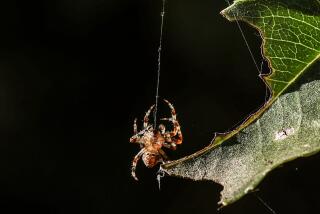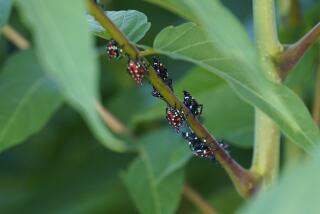Insect Aficionado Collects Rare Specimen
This is Rick Rogers in action.
On a grassy Palos Verdes hillock, he spies a buzzing hovering black spot.
“Aha!” he shouts.
His butterfly net extended, his nostrils flaring, he stalks the insect prey. With the deftness of long practice, the amateur entomologist nets it with one savage swoop and pops the creature in a specimen bottle where fumes of nail polish remover quiet its frantic wiggling in seconds.
“They just drop like flies, ha, ha, ha,” he says.
His specimen is a fly. A hover fly, to be more precise. Eupeodes volucris, to be scientific.
‘A Fly Artist’
Other people may swat flies, but not Rogers.
He likes them. He knows the scientific names of 1,000 different flies. He catches them. He studies them. He draws them.
“I’m one of the only diptera artists in North America,” he says proudly. “In other words, I’m a fly artist. I paint flies.”
This rare passion has its own peculiar rewards.
Rogers, 28, a resident of Hermosa Beach, believes he has found a fly nobody else has ever seen.
His find, discovered on a ramble through the Palos Verdes countryside, is a member of the genus Exoprosopa, a so-called bee fly, a type of fly named because its stubby body resembles that of a bumblebee.
Rogers caught it June 8, 1986, roaming the terrain off Barkentine Road. He was there conducting research--supported by the Palos Verdes Peninsula Audubon Society--for a forthcoming book tentatively titled “Insects of the Palos Verdes Peninsula.” So far, he has identified 327 different insect species and is about halfway through his research.
The fly Rogers found differs from other bee flies because of distinctive markings on its wings. He knew right away it was unusual.
“In 10 years of collecting, I’d never seen one,” he said.
He got another specimen April 27, 1987, in the same place.
Now Rogers is waiting for validation--with all the anxiety of a marathon pogo stick jumper hoping for news from the Guinness world records people--that he is the first person in the world to identify the fly as a distinct subspecies.
In the world of entomology, that sort of recognition occurs when an expert writes an article in a scholarly journal describing the find, sketching its life cycle and detailing the characteristics that differentiate it from others.
Rogers has started the process by checking his fly against specimens in museum collections. So far, nothing matches.
Bee Fly Specialist
But because he still must find an expert author, he took his fly to Jack C. Hall, a bee fly specialist who is a senior museum scientist at the Entomological Museum of the University of California at Riverside. Hall is a kindred soul.
“I have a quirk of liking to work on things that nobody else likes to work on,” declared Hall, who has a collection of 15,000 bee flies.
“I happen to be the only guy in the United States working on them. . . . Just between you and me, butterflies are a pain in the neck. . . . They occupy so much space. Bee flies, you stick a pin in them and you are ready to study them,” he said.
Hall at first threw cold water on Rogers’ hopes for quick recognition. “I have so many undescribed species right here that I will be busy the rest of my life” without writing about Rogers’ find, he said in an interview.
Relenting a bit, however, he said later, “If Rick would insist, I would write it up for him.” Rogers said he will urge Hall to write.
For Rogers, it would be icing on the cake if it turns out that the fly, in addition to being a new subspecies, is found only on the Palos Verdes Peninsula.
May Be Unique to Peninsula
The possibility that his bee fly, or other insects, may be unique to the Peninsula is the reason the Audubon Society is funding his research. The group doesn’t want to lose another species.
“In the last decade, we know we lost one butterfly,” Jess Morton, a member of the Peninsula Audubon Society, said at a recent meeting.
Morton, a self-taught specialist of spiders of the Palos Verdes Peninsula, was referring to the Palos Verdes Blue, a small pale blue butterfly that was rendered extinct about five years ago when the City of Rancho Palos Verdes unwittingly bulldozed its mating grounds to create a park. No development is planned where the bee fly was found because the land is considered too unstable for construction.
A typical research foray with Rogers is a constant series of interruptions as bugs fly past and the net whips out time and again.
“Here’s this baby! Isn’t that nice?” he asks, displaying a tachinid fly with a shiny black abdomen.
He stops to peer inside homemade insect traps--plastic boxes painted yellow that are filled with an antifreeze solution. The yellow attracts insects; the solution kills them.
“Aha! Look at this!” he shouts, examining the slosh of insects. “A bee I’ve never seen before!”
Luring a Spider
He spots a funnel-shaped spider’s web. The spider is hiding in a tiny dirt cave. To lure it out, Rogers places a stunned fly on the web and then laughs as the spider dashes out to grab lunch.
A large butterfly flutters by.
“Holy mackerel! Did you see that? A swallowtail!” He runs after it but the brightly colored insect gets away.
“You know, if I’m doing good collecting, I can stay out all day until it gets dark. I forget about hunger, thirst,” he says. “Three times in the desert, I about passed out getting back to the car.”
Rogers is able to turn his calling into a living. He sells drawings of insects and is working on a contract to produce an insect inventory on land owned by Los Angeles International Airport.
But, he concedes, his love of creepy crawly things has not made him popular with women.
On the wall of his tiny Hermosa Beach apartment, his prize specimen case contains a Titanis gianteas from the Amazon River Basin mounted in prime position, its wings spread out eight inches.
“When I have someone over, I have to take the insects off the wall. Having the world’s largest insects is not the right way to start things,” he said.
“It is a lot easier meeting a new fly.”
More to Read
Sign up for Essential California
The most important California stories and recommendations in your inbox every morning.
You may occasionally receive promotional content from the Los Angeles Times.










